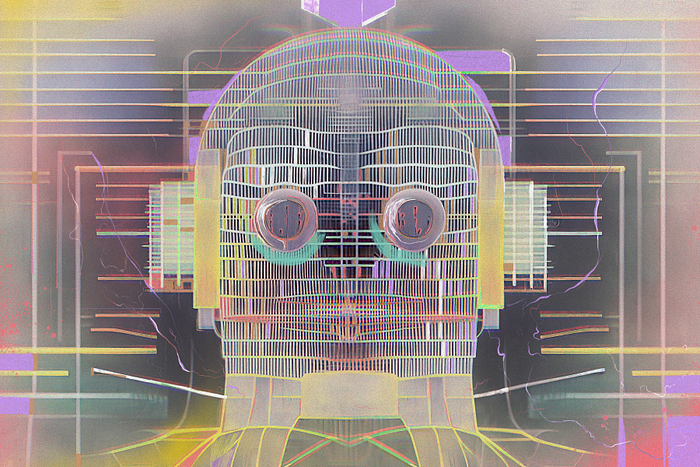

Harmony in automation & creativity
source link: https://uxdesign.cc/harmony-in-automation-creativity-1ce09ab9dab8
Go to the source link to view the article. You can view the picture content, updated content and better typesetting reading experience. If the link is broken, please click the button below to view the snapshot at that time.

Harmony in automation & creativity
The incoming AI-driven evolution of design systems.

Created with Midjourney and Procreate
For the past decade, I’ve had the privilege of contributing to design and brand systems, and I’ve grown to appreciate the challenging yet rewarding process of scaling creativity. Despite the satisfaction that comes with this work, achieving this kind of cross-company alignment and validating it with customers to bring these system-wide ideas to fruition can be a long and sometimes bumpy road.
In my experience, Figma has been a key part of making this kind of collaboration smoother. First, it has made consensus building so much easier by giving us a tool that is equally accessible to everyone in the process. But it has also allowed design components to evolve in real-time with emerging concepts across really large teams, helping designers achieve the kind of coherence that customers want.
Design tokens have also played an important role by enabling us to move away from the rigidity of hard-coded values and towards flexible designs that can be adapted and refined instantly. This newfound speed has reduced product ship cycles and allowed for the rapid development of new ideas, getting the latest and greatest into users’ hands faster than ever before.
Although I see flaws in the agile design model, I credit it with helping us leave behind the old hierarchical decision-making processes, and in moving towards a cycle of ongoing customer feedback. Still, prioritizing joyful, beautiful, artfully crafted moments in UX at scale remains an art in itself. Something that likely every visual, sound, and motion designer in the tech industry will attest to. So, I celebrate everyone out there who recognizes the importance of these elements and continues to prioritize them.
Now, as 2023 begins, AI enters the mix in brand new ways, and I wonder how it will change our industry. 👁️👄👁️
Could this be the end of design systems as we know them?
In the last few months, several startups, such as Galileo AI, Bifrost, Diagram, Modyfi.io, Anima, and many others, have entered the generative design tool space and gained attention. Their software integrates with apps like Figma and Sketch, allowing design teams to create brand-new interface designs with simple text prompts, automate tedious tasks, and convert design concepts into clean code.
It’s like magic! 🪄
With such rapid advancements, it’s plausible that soon enough, apps, websites, games, and entire digital ecosystems will be able to generate and maintain themselves.

It’s clear that the years ahead present an opportunity to evolve beyond the limitations of static design systems and embrace fully generative ones that are also contextual, adaptive, and intelligent. Furthermore, with roughly 5.2 billion people connected to the internet, it’s critical that whatever we build can adjust intuitively to individual abilities, input types, and aesthetic preferences.
In other words, it’s a chance to build a nimbler foundation where accessibility, individual expression, and personalization can adapt generatively to each person’s preferences, creating one-of-a-kind interactions for everyone.
Although the impact of generative design on everyday UX is still uncertain, I can see that one of the first changes may be in the way we approach the aesthetics of product systems, including brand and marketing. Generative brand expressions are coming whether we want them or not. 🫣
So, what’s left for designers, writers, and illustrators alike?
The rigidity of brand systems and their guidelines has been there for some good reasons, like streamlining the creative process and ensuring consistency, all of which help in building brand equity and protecting its integrity.
Despite all the innovations we are seeing in AI, this part of the creative process is likely to stay mostly unchanged for a while. Instead, what might evolve sooner is how we use brand principles to guide creative production, such as converting them into prompts that AI systems can understand. Said differently, a new role might be AI Art director, as someone that can finetune ways to guide the creation of copy in the voice of a brand like Nike’s or the aesthetic of images for a brand like Porsche.
Does that mean that our roles will evolve into conductors of machines that do all the heavy lifting? I prefer to think of this relationship as a co-creation, and as my colleagues at Microsoft described, we can engineer incoming AI tools to be our co-pilot. 🧑🏼✈️
For most strategists and makers that give a brand its shape and form, the early phase of exploration and discovery in every assignment happens to be the most fun and interesting part. Those moments of trial and error are the enviable bits that everyone wants to be a part of. As new AI-powered tools and processes in art and design come and go, it may be tempting to automate more than it’s really needed. How may we ensure that we protect the most satisfying moments in the creative process for people, not machines?
These are my personal concerns as a digital artist and designer, and I am proud to be at Microsoft where we take Responsible AI principles and practices seriously. Are there similar approaches where you work? 🤔
What are some of your thoughts on this topic? Please share some of your most pressing considerations on the impact these technologies can have on UX, brand design or any other creative field you are part of. 👀
Recommend
About Joyk
Aggregate valuable and interesting links.
Joyk means Joy of geeK